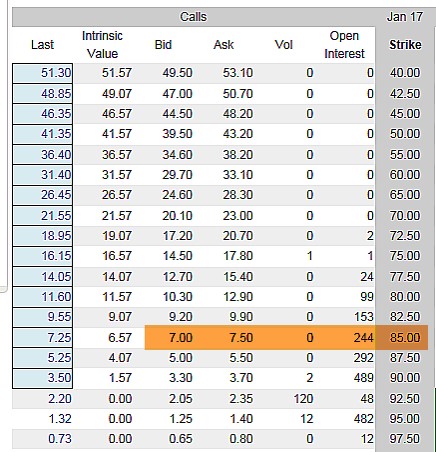The mid-contract unwind (MCU) exit strategy is a position management maneuver we use to generate a second income stream in the same month with the same cash investment. The opportunity arises when share price moves significantly higher than the short call strike in the first half of a contract.
This article will highlight a real-life example and a hypothetical set of circumstances wherein a short-term infusion of cash will be taken and immediately re-paid in order to accomplish this exit strategy.
Hypothetical circumstances
- We have a portfolio with a cash value of $100k
- We select 7 stocks and allocate approximately $14,000.00 per position
- We set aside $2,000.00 for potential exit strategy use
- One of the stocks we buy in mid-December 2016 is IDCC (200 shares at $85.00 per share)
- We sell 2 January 2017 $85.00 at-the-money calls for $2.50
- We have already used $1500.00 (in this hypothetical scenario) of the $2000.00 exit strategy cash reserve, leaving $500.00 for additional position management maneuvers
- On 12/28/2016, IDCC is trading at $91.50, well above the $85.00 strike and the MCU strategy is being considered
Initial calculations when entering this trade

This initial trade offers a 1-month, 2.9% return with no upside potential and no downside protection of this profit. The breakeven price is $82.50.
Real-life options chain showing cost-to-close

The bid-ask spread is $7.00 – $7.50. We will leverage the Show or Fill Rule and assume a buy-to-close price of $7.35. With the stock trading at $91.50, this premium represents $6.50 of intrinsic value and $0.85 of time value so the actual cost-to-close 2 contracts is $170.00 ($85.00 x 2).
However, the cash required to buy back the 2 contracts is $1470.00 ($7.35 x 2) and we only have $500.00 in cash reserve remaining in this hypothetical. We find ourselves short $970.00. If we close, our shares will go up in value by $6.50 per share from its current practical value of $85.00 (our contract obligation to sell at this price). This represents a credit of $1300.00.
How to resolve this issue
We will need to infuse the $970.00 into our brokerage account from another resource. Sometimes we can tie our checking account to our brokerage account and accomplish this in seconds. Once the stock sale is confirmed a few days later, we can replace this “short-term loan” with the cash profit generated by the stock sale. This will still leave us $330.00 additional cash in our brokerage account we didn’t have before initiating the MCU exit strategy ($1300.00 – $970.00).
Discussion
There are (infrequent) scenarios when our brokerage account will need an additional infusion of capital in order to accomplish exit strategy opportunities. The MCU exit strategy is the main scenario when this may be required. Although most of the time our reserve of 2% – 4% will be adequate, we must account for the unusual situations when additional capital is required.
Next live event
American Association of Individual Investors
Washington DC Chapter
Saturday July 15, 2017
9 AM – 12:00 PM
“Using Stock Options to Buy Stocks at a Discount and to Bring Portfolio Returns to Higher Levels”
Co-presenter: Dr. Eric Wish, Finance Professor, University of Maryland
Market tone
Global stocks declined this week after the S&P 500 Index posted a new record high on Monday. Falling oil prices have been a cause for investor concern. West Texas Intermediate crude fell to $42.65 a barrel on Friday from $44.70 a week ago, near a seven-month low. Volatility, as measured by the Chicago Board Options Exchange Volatility Index (VIX), declined slightly to 10.02 from last Friday’s 10.9. This week’s economic and international news of importance:
- The price of a barrel of West Texas Intermediate crude oil extended its decline this week amid rising global inventories. WTI prices have fallen more than 25% from their $58.30 high, which was posted on the year’s first trading day
- The decline in energy prices will make it more difficult for the US Federal Reserve to reach its 2% inflation target in the near future
- Negotiators from the United Kingdom and the European Union met on Monday in the first formal Brexit negotiating session. Late in the week, Prime Minister Theresa May met with EU leaders in Brussels and laid out her plan to protect the rights of the three million EU citizens living in the UK, allowing them permanent residence
- After years of fighting for inclusion in MSCI (BE:MSCI) influential stock indices, China finally received word that some of its A shares will be included in the indices in mid-2018. These restrictions are an effort by MSCI to incentive China to further liberalize its stocks markets
- Fed governor Jerome Powell told a congressional committee that US regulators have room to relax or eliminate some aspects of the Volcker rule, which is intended to limit banks’ ability to make speculative bets with insured deposits. Regulators are looking for ways to simplify the complicated rule and may exempt small banks from having to comply
- US treasury secretary Steven Mnuchin said the government will only issue ultra-long maturity Treasuries if there is sustained interest for the securities
- Thirty-four big US banks passed the first round of the Fed’s stress test this week
- Next week, the central bank will announce whether it will allow the banks to return capital to shareholders. Some banks may begin to reduce their capital if the Fed approves. That could be seen by markets as a sign of confidence that the banking system is strong and positioned well to withstand a significant economic downturn
THE WEEK AHEAD
Mon, June 26th
Tue, June 27th
- Case-Shiller home price index
Wed, June 28th
- Trade balance
- Pending homes sales
Thurs, 29 June
Fri June 30th
- Q1 gross domestic product revision UK
- Preliminary June consumer price index eurozone
- Personal income/spending
For the week, the S&P 500 moved up by 0.21% for a year-to-date return of 8.91%.
Summary
IBD: Confirmed uptrend
GMI: 5/6- Buy signal since market close of April 21, 2017
BCI: I am fully invested in the stock portion of my portfolio currently holding an equal number of in-the-money and out-of-the-money strikes.
WHAT THE BROAD MARKET INDICATORS (S&P 500 AND VIX) ARE TELLING US
The 6-month charts point to a cautiously bullish outlook. In the past six months, the S&P 500 was up 7.5% while the VIX (10.02) moved down by 12.5%.
Much success to all,
